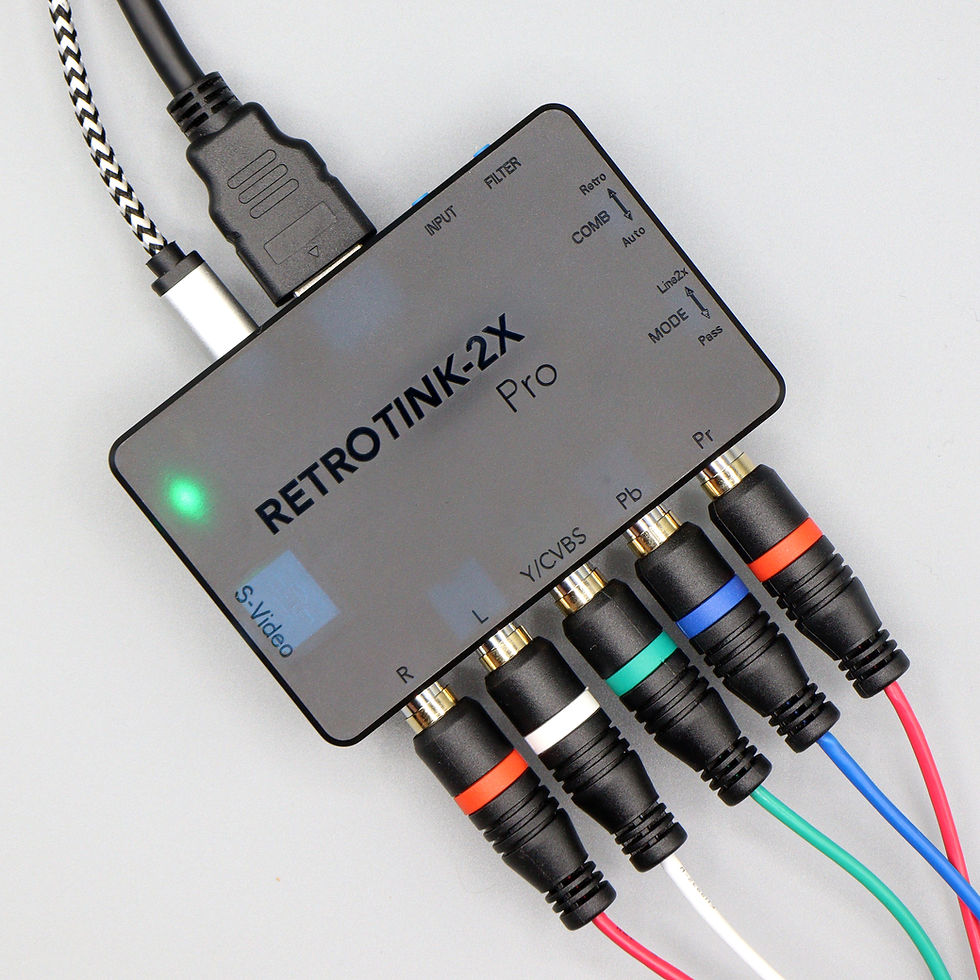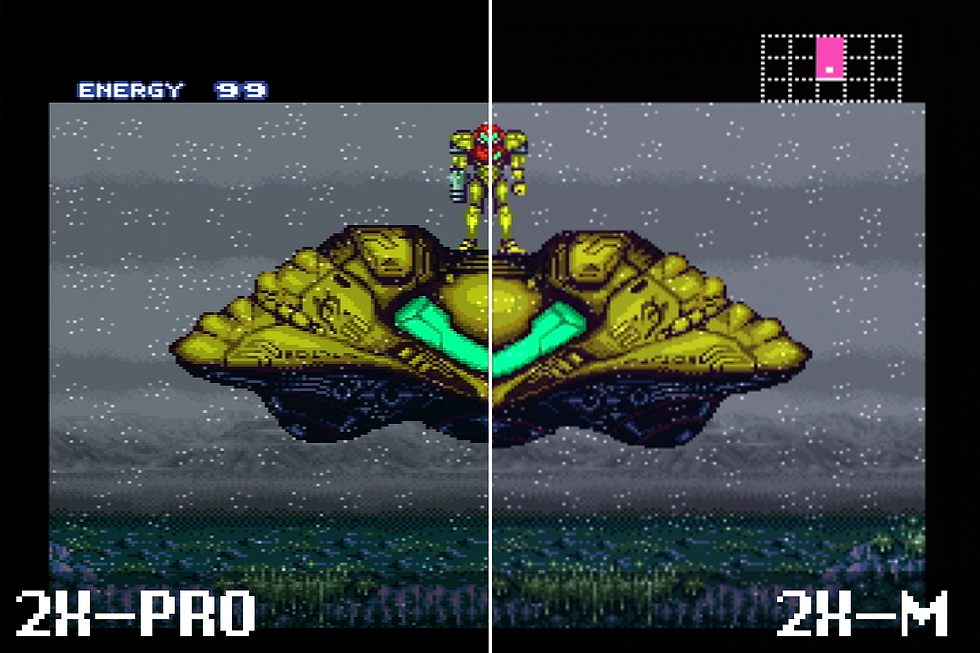Introducing the RetroTINK-2X Pro Multi-format
- Mike Chi

- Aug 17, 2020
- 5 min read
Updated: Sep 15, 2020
Support for 480p pass-thru capability has been one of the biggest requests ever since we released the original 2X in 2018.
Today, we are proud to announce the RetroTINK-2X Pro Multiformat (RT2X-M) , the latest device in our lineup capable of zero-lag pass-thru of 480p component inputs while zero-lag line-doubling 240p/288p/480i/576i component, S-Video and composite inputs.
The 2X-M is in stock and ships immediately at a MSRP of $129.99. Pricing is identical to the 2X-Pro, in line with the idea that the two are complementary products for different use cases.

Here are some sample captures from the RT2X-M in 480p.

DC -> RetroGamingCables SCART (480p Mode) -> RGB2COMP

DC -> RetroGamingCables SCART (480p Mode) -> RGB2COMP

PS2 -> Generic Component Cables

PS2 -> Generic Component Cables
Before going further, I'd like to make three important statements:
The 2X-M does not replace the current 2X-Pro. If you already own the 2X-Pro or are looking for the best device for connecting non-480p capable consoles, the 2X-Pro is almost certainly still the best choice for you.
Although the enclosures are similar, the 2X-M is based on a completely different chipset. It is not possible to add 480p pass-thru capability to the existing devices. Otherwise, we would have just released the new firmware and called it a day!
The 2X-Pro remains our flagship product and will be produced and supported into the foreseeable future. On the other hand, the 2X-M may be a limited release only.
Is the 2X-M Right for Me?
The 2X-M is intended for users who are primarily focused on the later generation of analog output consoles (PS2-era) that are capable of 480p output, while still having the option of zero-lag line doubling 480i/240p for non-480p titles and older consoles.
Compared to the 2X-Pro, the 2X-M has slightly different, but still zero-lag, handling of 240p (and other standard definition modes). Take a look at the examples below to see what you prefer and what makes sense for your setup.
When not using 480p pass-thru, the biggest difference between the 2X-M and 2X-Pro is the vertical scaling. The 2X-M is locked into a bilinear filter, whereas the 2X-Pro uses nearest neighbor (in 'blocky' mode) or an edge blender (in 'smoothing' mode). The result is a slightly softer output for the 2X-M, as seen below. However, the difference after rescaling by your TV to 1080p or 4K for display may be not very noticeable to you. Nevertheless, we would recommend the 2X-Pro for people interested exclusively in 2D consoles.

SNES 1-Chip -> HD Retrovision Component Cables
One thing to keep in mind is that the 2X-M does not include an edge smoothing filter, which many people liked for the N64. Take a look below to see if you prefer the aggressive edge smoothing filter or a simple bilinear filter for the N64.

N64 -> RetroAccess S-Video Cable
However, the differences between the 2X-Pro's blocky/smoothed output and the 2X-M's normal bilinear output is much less visible for non-N64 games. Check out the Chrono Cross example below. The 2X-M also recovers a tad faster on 240p <-> 480i transitions. For Playstation users, the 2X-M is worth a look, especially if you're using a PS2 and have some 480p titles.

PS2 -> Generic Component Cable (B=blocky, S=smoothing)
One use case where the 2X-M shines over the current 2X-Pro for 240p sources is the handling of composite video.
In the Super Mario NES title card, the 2X-M's output is noticeably cleaner with less dot artifacts and no ghosting around sharp vertical lines. If your setup exclusively focuses on composite video, the 2X-M will generally produce better results. Due to composite artifacts, the difference between nearest neighbor and bilinear filtering is much less visible.
Our testing has also shown that the 2X-M's composite decoder is more robust and and may handle poorly behaved sources such as the Sega Genesis and earlier PSOne models, where the 2X-Pro fails to produce a correct image.
As with the 2X-Pro, we spent a significant effort calibrating the video decoder's settings to produce results that are accurate and respectful of retro consoles. Take a look at how closely the colors match in the composite as well as other examples.

NES -> Composite Cable
Summarize it for Me Again!
The existing 2X-Pro is still our flagship product while the 2X-M is an addition to our line up to fill the specific 480p gap.
Check out the flow chart to help you decide which device might make sense for your setup.

2X-Pro vs 2X-M Flow Chart
For our Streamer Friends
If you're a streamer that's comfortable adjusting and tuning the various scaling/filter in settings in software like OBS, the 2X-M might be a very good choice for capturing video from all console generations. Operating in pass-thru mode bypasses the vertical bilinear filter and allows you to use pixel sharp point scaling to your final resolution. In this use case, you can take advantage of the 2X-M's better horizontal resolution and composite decoder without the drawback of bilinear filtering.
Misc. Notes
The 2X-M has the same scanline modes as the 2X-Pro, including 480i interlace simulation. Video output in scanline mode is virtually identical between the two devices. Scanlines only work in 240p/480i/288p/576i.
The 2X-M also has a pass-thru mode. The image quality between the 2X-M and 2X-Pro in pass-thru is also virtually identical with the exception of improved composite decoding on the 2X-M.
The 2X-M also supports PAL and PAL-60 over composite and S-Video. PAL-M, PAL-N and SECAM support is enabled but not tested. Potential compatibility problems are likely fixable via firmware update, but no guarantees.
Currently, the 2X-M does not support 576p input, although the hardware is capable. Once I get enough systems to test 576p, it will likely be rolled in via a future firmware update.
The 2X-M uses a 4:2:2 chroma subsampling for all modes of operation. This has no impact on composite or S-video since those formats inherently have low color resolution. For 240p games the impact is minimal. The effect is mainly pronounced for 480p systems that output full 4:4:4 YPbPr. If you are sensitive to chroma subsampling, the best choice for you is the OSSC. Note, though, the Wii operates natively in 4:2:2, so there is minimal impact in that use case.
Update: Version 1.2 of the firmware adds a "pseudo RGB444" mode for 480p inputs. Since this mode is not 100% complaint with CEA-861 480p timing and is essentially overclocking the system, consider this a bonus and not a selling feature until it has been sufficiently validated.
The 2X-M inherits all of the usability and quality of life features first introduced in the 2X-Pro including USB firmware upgrade capability and advanced power supply noise filtering . The 2X-M also utilizes a microcontroller with significantly more memory, which may enable future tweaks and options.
At this point, I consider the RetroTINK-2X family full and complete. There will not be a SCART version of the 2X-M since SCART/RGB is not standardized for 480p sources. Aside from releasing the MINI, all resources are now focused on higher resolution products capable of scaling to 720p and/or 1080p resolutions.
No timeline or features since development is still at an early stage, except that our design objective is plug-and-play simplicity with great image quality and respect for the original game content.






Comments